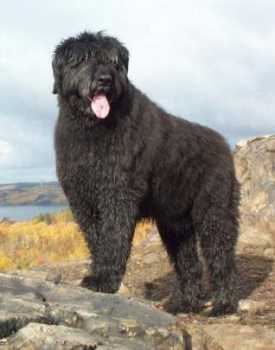Herr Louis Doberman was a tax collector cum dog-pound keeper who had to travel through dangerous areas. He needed assistants tough enough to protect him from bandits and to con-vince reluctant tax payers to cough up. He performed his duties with "a grave digger and a be-llringer"—and a few basic established breeds. In the late 1860s, he determined to create his own personal guardian, a dog that would look much like a large Miniature Pinscher.
Breed type was fixed in an amazingly short period of time. Dobermann utilized the old German Shepherd type for hardiness, intelligence and soundness, with German Pinscher blood for quick reaction and terrier fire. The Weimar Pointer donated hunting abilities and fine nose, as well as the dilute colors. Added to the strength, guarding instinct and courage of the Rottweiler, the breed needed only the English Greyhound for speed and the Manchester Terrier to give it a short, sleek coat. Dilution fac-tors which produce the reds, blues, and fawns, despite their uncommon appearance, have been present in the general mastiff gene pool since the beginning.
In the early years of the breed, they were extremely sharp, willing to attack "even the devil himself." An early owner, Gottfried Liechti, recorded ". . . it required a good deal of courage to own one." In fact the breed's reputation preceded it to America. One early import won three Best in Shows before any judge had the courage to examine his mouth—only to find several missing teeth, a serious fault in the breed!
Some longhaired and natural bobtail pups were born in the early years. The bobtails were much admired, resulting in the current docking fashion. Earcropping in the long, stylish Ameri-can show cut or the wider, shorter pet cut aided the ears to stand. Dewclaws were removed, completing the racy appearance.
After Dobermann's death, Otto Goeller continued promotion of the breed and is credited with improvement. Goeller's kennels produced the first notable stud dog, Hellegraf von Thueringen.
The breed began infiltrating American coastlines around the time of WWI. Many Dober-mans left in Germany were drafted; others were euthanized, due to the scarcity of food. After the war, the breed's population once again began to rise in its homeland.
The Bulldog may be the official mascot of the US Marine Corps, but the Doberman has the distinction of being named the Marine War Dog. The breed is loyal to its master and will do almost anything requested of it, from exciting drill team performances to schutzhund training. Dobermans have representatives in search-and-rescue, patrol or police dogs and as dog guides for the blind.
One of the breeds that strikes fear in the heart of many, the Dobe's reputation is generally unearned. It is a natural, loyal guard, but the breed has been mellowed to allow the approach of strangers. Socialization and authoritative discipline are recommended, along with a heritage of sound temperament. The Doberman of today is a handsome, light-footed aristocrat which prefers being with its owners to all other things.
Breeds navigation
Looking for the source of custom dog collar ? Please click here to see exclusive items
Need high quality and well priced custom dog collar? Here you can find some
|

